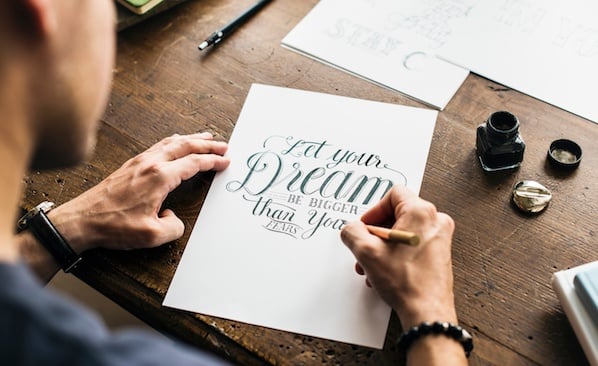Mastering the Art of Calligraphy
Introduction
Are you fascinated by the elegant strokes and mesmerizing beauty of calligraphy? Do you dream of mastering this art form and creating your own stunning pieces? Look no further! In this comprehensive guide, we will explore the world of calligraphy and provide you with valuable tips, techniques, and resources to help you on your journey towards becoming a calligraphy maestro.
Whether you are a beginner eager to explore the basics or an experienced artist seeking to refine your skills, this article is designed to be your go-to resource for mastering the art of calligraphy. So, let's grab our pens, dip into the ink, and embark on this creative adventure together!
The Basics of Calligraphy
Before we dive into advanced techniques, let's start with the fundamentals of calligraphy. Understanding the building blocks of this art form will provide you with a solid foundation on which to build your skills. Here are some key points to get you started:
Choose the Right Tools: A calligrapher's toolkit typically consists of a pen or brush and ink. Depending on the style of calligraphy you wish to pursue, you can opt for a dip pen, a brush pen, or a fountain pen with a calligraphy nib. Experiment with different tools to find the one that suits your preferences and style.
Master the Strokes: Calligraphy is all about creating beautiful, flowing lines. Practice the basic strokes, such as the upward stroke, downward stroke, and curve, to develop control over your pen or brush. These strokes form the foundation of letters and will help you achieve consistency and grace in your writing.
Understand Letterforms: Each calligraphy style has its own unique letterforms and characteristics. Whether you are interested in traditional scripts like Gothic or modern styles like Copperplate, take the time to study and analyze the letterforms. Pay attention to the proportions, spacing, and angles to create well-balanced and visually pleasing compositions.
Tips and Techniques for Calligraphy Mastery
Now that you have a grasp of the basics, let's explore some tips and techniques that will elevate your calligraphy skills to new heights. Here are a few invaluable resources and strategies to guide you along the way:
Practice, Practice, Practice! Like any other art form, practice is the key to mastery in calligraphy. Set aside dedicated time for regular practice sessions. Focus on drills to improve your muscle memory and work on specific letterforms to enhance your technique. Check out resources like Learn the Art of Calligraphy and Smashing Magazine's Calligraphy Lessons for insightful tutorials and exercises.
Explore Different Styles: Calligraphy offers a vast array of styles, each with its own unique charm. Experiment with various scripts like Gothic, Italic, or Uncial to broaden your artistic repertoire. Immerse yourself in the nuances of each style and adapt them to your personal aesthetic. The Calligraphy Skills website provides a comprehensive overview of different calligraphy styles and their characteristics.
Learn from Experts: Seek inspiration and guidance from seasoned calligraphers. Online platforms like Lettering Daily, Vial Designs, and CreativeLive offer valuable tips, tutorials, and workshops by renowned calligraphy artists. Their expertise and insights will help you refine your skills and expand your creative horizons.
Develop Your Own Style: While learning from established calligraphers is essential, don't be afraid to develop your unique style. Experiment with different tools, letterforms, and compositions to discover your artistic voice. Embrace your individuality and let your personality shine through your calligraphy. Remember, calligraphy is not just about replicating existing styles but also about expressing your creativity.
Frequently Asked Questions
Can I learn calligraphy if I have bad handwriting? Absolutely! Calligraphy is a separate art form that doesn't rely on your everyday handwriting skills. With practice and dedication, anyone can learn calligraphy and improve their penmanship.
What type of paper should I use for calligraphy? Choosing the right paper is crucial for achieving optimal results in calligraphy. Look for smooth, heavyweight paper that won't absorb ink too quickly. Specialty calligraphy papers or high-quality bristol board are excellent options.
Is calligraphy expensive to get started? Getting started with calligraphy doesn't have to be expensive. Basic calligraphy tools such as a pen, ink, and paper are relatively affordable. As you progress, you can invest in more specialized tools and materials if desired.
Conclusion
Mastering the art of calligraphy requires patience, practice, and a genuine passion for the craft. With the right tools, techniques, and resources at your disposal, you can embark on a fulfilling artistic journey. Remember to embrace the learning process, explore different styles, and find your own creative voice. By immersing yourself in the world of calligraphy and dedicating time to honing your skills, you'll unlock the beauty and expressiveness of this timeless art form. So, let your imagination flow, and may your calligraphy journey be filled with endless inspiration and artistic growth!
For further inspiration, check out these amazing examples of calligraphy:
- 7 Incredible Examples of Gothic Calligraphy
- Tips and Strategies for Young Starving Calligraphers
- The Aesthetics of Truth: Art and Calligraphy

Comments
Post a Comment